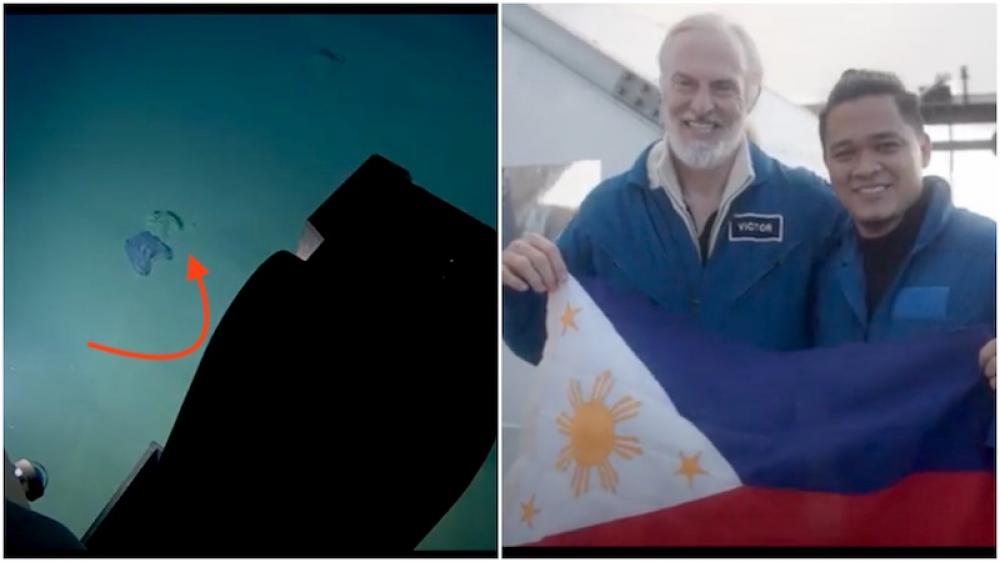Just Earth News | @justearthnews | 03 Jun 2021, 09:08 am Print
 Plastic Pollution
Plastic Pollution Image Credit: Caladan Oceanic YouTube Screenshot
A Filipino scientist waiting to be thrilled by the secrets of the world's third deepest ocean trench was taken aback by a not so uncommon site when he spotted a 'white object' floating in the waters only to realise that it was just plastic.
According to a CNA report on his adventurous trip to one of earth's final frontiers, the Emden Deep, microbial oceanologist Dr Deo Florence Onda was expecting to witness breathtaking views in one of the oldest sea beds of the world where no human had stepped before.
“When we were about to reach the bottom I was expecting to see scary, crawling things sneaking in or peeking into the windows,” Dr Onda was quoted as saying in the CNA report.
American explorer Victor Vescovo from Caladan Oceanic, a private organisation dedicated to advancing undersea technology, was accompanying him in the exploration project, the report informed.
The 33-year-old professor at the University of the Philippines Marine Science Institute said when they descended into the grand depths of the ocean they hoped to see a "glimpse of life below" of the Emden Deep, a part of the Philippine Trench.
They continued their exploration over a 12-hour period in March.
“There was one funny scene when we were exploring the area. There was one white material floating around. I was saying ‘Victor, that’s a jellyfish’. We went there and approached and it was just plastic.
“The only unusual thing there was the garbage. There was a lot of garbage in the trench. There were a lot of plastics, a pair of pants, a shirt, a teddy bear, packaging and a lot of plastic bags. Even me, I did not expect that, and I do research on plastics,” he said.
The site of garbage and plastic on the oldest sea bed revealed the extent and seriousness of plastic pollution, he noted.
“Seeing it for the first time was a privilege as a human being, representing 106 million Filipinos and billions of people of the world. But being a witness to the extent of pollution, and being a witness to the gravity of the plastics problem from the surface to the bottom of the ocean, is another thing.
“It becomes my responsibility to tell people that their garbage doesn't stay where they put it. It goes somewhere else and it will sink.”
Though the planned scientific mission could not be conducted because of bureaucratic difficulties and Covid-19 situation, Dr Onda said the trip "gave him fascinating insights and a platform to detail the issues facing the deep-sea environment, an area that is difficult to research in the Philippines due to logistics and costs", according to the report.
Dr Onda is studying the life cycle of microorganisms such as phytoplanktons which produce oxygen through photosynthesis and are among the main energy contributors and biomass build-up in the marine ecosystem.
“Microorganisms are the main drivers of carbon storage, which then drives climate change. When phytoplankton consume carbon, taking carbon dioxide from the atmosphere, they convert it into particulate organic matter that sinks to the bottom of the ocean and gets stored for millions of years,” he said.
Onda is concerned about the transboundary nature of plastic spread and its unknown but deep impact on marine ecosystems and on those elements that form the foundation of life on earth, according the report.
Meanwhile, more research is required to know how trash reaches the deepest areas of ocean bed, crossing great distances and different water densities.
- Global water bankruptcy shock: Why the planet’s most precious resource Is collapsing
- Would you pay $1 million to stay on the moon? This company thinks so
- A historic UN deal is about to transform how the world protects its oceans
- Back to the Moon after 50 years: NASA readies historic Artemis II Mission
- T. rex took 40 years to become a monster—You won’t believe how scientists found out





-1763561110.jpg)
